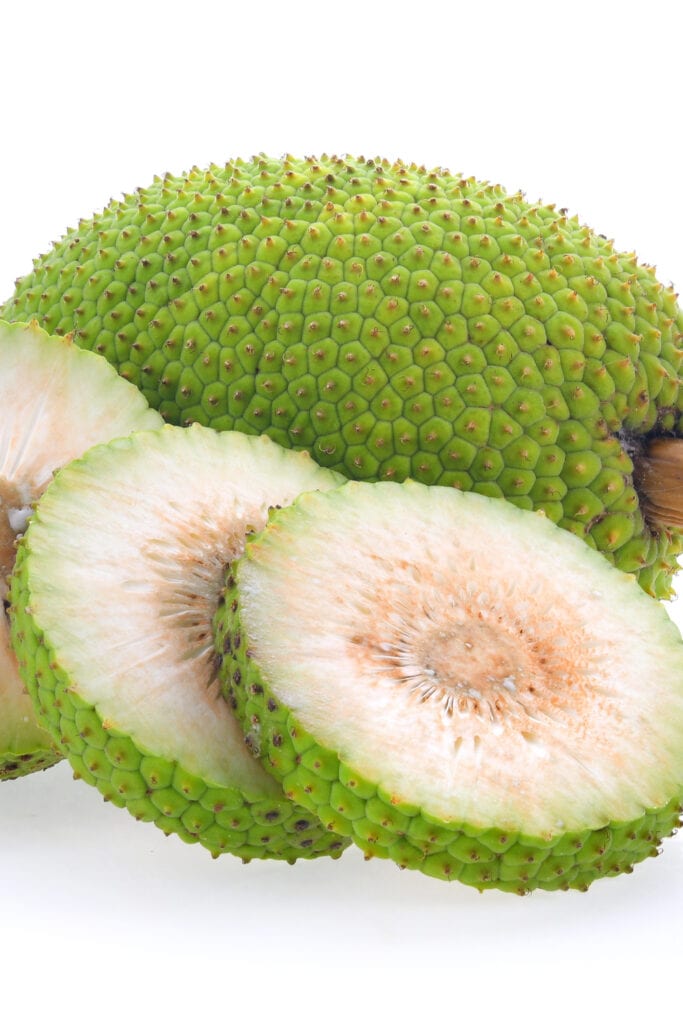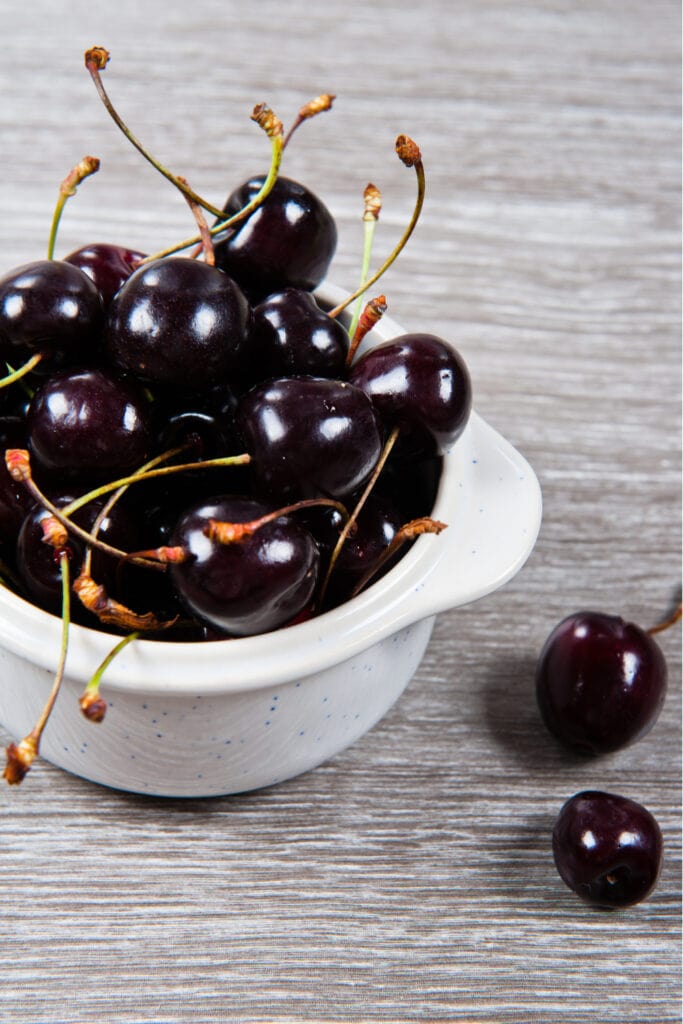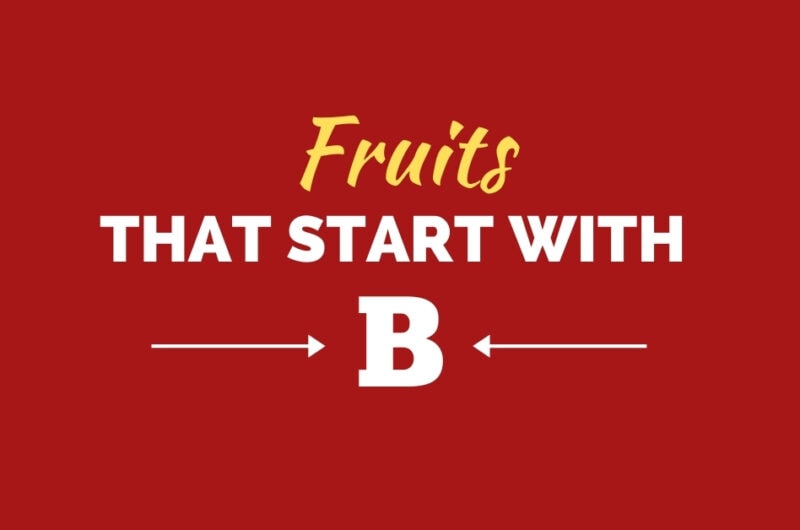We all know that “‘B’ is for ‘Banana,’” but there are plenty of other fruits that start with B.
This was one of those fun, easy-to-create lists that could practically go on forever.
Many of the fruits on this list are ones you probably already know, such as bananas, blueberries, blackberries, blood oranges, and black cherries.
However, there are also plenty on here that you may not be familiar with. These include more exotic fruits like barbadine, bignay, and blue java bananas.
You might even see a few things on here that surprise you!
So sit back, relax, and enjoy this list of 30 ‘B’ fruits!

1. Blueberries
Blueberries are one of my top three favorite berries. They’re one of the smaller berry types, and they are, as their name suggests, blue.
They range in flavor from sweetly tart to super sweet. The darker the berry, the sweeter it seems to taste.
They’re high in antioxidants, low in calories, and good for people with diabetes and high blood pressure.
They also taste amazing on ice cream, in cereal, or when made into blueberry cobbler.

2. Banana
Bananas are the highest-selling fruit in the United States. They’re also the second-highest worldwide. (Tomatoes hold the number one spot globally.)
They’re long, curved, and turn from green to yellow when fully ripe.
They’re an excellent source of potassium, and chances are, no matter where you live in the world, you’ve had a banana at least once.

3. Blackberry
Although they’re available year-round, blackberries are freshest and most popular in the summer.
In reality, blackberries, like raspberries, aren’t really berries. Instead, they’re several tiny drupe fruits that have grown together in tight clusters.
They’re deep black with purple highlights in the right light, and they’re soft and full of juice.
They have a unique flavor that’s somehow earthy, sweet, and a little sour all at once.

4. Birne
‘Birne’ is the German word for ‘pear,’ so whether you like Bartletts or Anjous, you’ve probably had a birne or two in your lifetime.

5. Boysenberry
What do you get when you cross a blackberry, raspberry, dewberry, and loganberry?
As much as that might sound like the lead-in to a bad joke, it’s not. Boysenberries are hybrids of those four berries.
They’re shaped like oversized blackberries, and they range in color from ruby red to a deep maroon.
They’re incredibly juicy, a tiny bit tangy, and have just a hint of a floral flavor.

6. Breadfruit
Breadfruits are related to and look a lot like jackfruit.
They’re yellow with lots of spiky bumps all over their surface, and they’re about the same size as a small watermelon.
Their insides are white and have a neat starburst pattern in their centers when cut in half.
You can eat them raw once they’ve ripened, or you can cook them and eat them before they’re ripe.

7. Berries
I know that I’ve already added several berries to the list, but so many of my favorites didn’t make the cut, so I included the broad category of berries so that I could talk about them too.
Berries are some of the best-selling fruits all over the world.
They include lots of peoples’ favorites, such as those listed here and strawberries, raspberries, cranberries, goji berries, and even bananas!
Technically, even eggplants are berries. Yeah. Wrap your mind around that.

8. Bell Pepper
Despite what most people think, bell peppers – and all other peppers – are fruits, not veggies.
Bell peppers are primarily mild in terms of heat, and there are all different colors, including green, red, yellow, purple, black, brown, and orange.
They’re easily distinguished by their plump, bell-like shapes with either three or four humps on the bottom.
(There are a few varieties shaped differently, but most fall into this category.)
The green, black, and brown peppers are slightly more earthy, while the red, yellow, orange, and purple varieties are somewhat sweet.

9. Beans
I will fight against this until the day I die. Beans are legumes, and legumes are nothing except legumes.
However, science says they’re technically fruits, so I added them to the list.
10. Beach Plum
Beach plums are round and dark purple, and they look a lot like the typical plums you’d find in the grocery store.
The difference is that these plums grow naturally along beaches in the sand.
You can find them all along the eastern coast of the United States.
They have a bittersweet kind of taste that’s like a mixture between peaches and cranberries.

11. Barbadine
Barbadines are also known as giant granadillas. They range in color from light green to yellowish-orange.
They’re hard-shelled, and to eat them, you’ll crack them open like an egg.
They’re a type of passion fruit, and like passion fruit, you eat them by opening them and eating the insides – flesh, seeds, and all.
They’re more sour than sweet, but if you enjoy tart fruits, you’ll like barbadines.

12. Barbados Cherry
Barbados cherries aren’t actually cherries; they just look like cherries.
They’re small, round, and bright red. (They also resemble crabapples if you’ve ever seen those.)
They’re both sweet and sour, kind of like a cross between a lemon, an apricot, and a strawberry.
If you eat too many, your tongue might get a little tingly.

13. Bignay
Also referred to as the Queensland cherry or the Chinese laurel, bignay fruits come from the Antidesma bunius tree, found in parts of southern Asia and northern Australia.
The berries are small, about the size of blueberries, and start out white.
Eventually, they ripen to red, then black. Once they’re black, you can eat them raw. They taste sweetly tart.
If eaten while any other color, they’re super sour and bitter. No other part of the tree is edible, and the roots are toxic.

14. Blue Plums
Blue plums are so-called because of their bright blue skins.
They’re smaller than traditional plums, about the size of cherries, and they have lovely golden insides.
They’re somewhat bitter when eaten raw, but they taste great in jams and jellies.
15. Blood Limes
Blood limes are shaped like regular green limes, but they’re slightly smaller, and their skins are rusty red, hence the name.
The inside of the limes is more orange than red, and unlike green limes, many people enjoy eating blood limes raw by themselves. You can even eat the skin!
They also taste amazing when made into marmalade.

16. Black Cherry
Black cherries are the same size and shape as red cherries, but they’re much darker.
While not truly black, they’re a very dark maroon-red, with some almost bearing a purple tint to their skin.
Aside from their colors, the two cherries differ in other ways. For example, black cherries are both softer and sweeter than red cherries.
Both are low in calories and high in health benefits.

17. Black Raspberry
Black raspberries look almost exactly like blackberries, and people often confuse the two.
They’re not the same thing, however. Black raspberries are hollow inside, whereas blackberries aren’t.
Black raspberries are also much sweeter than blackberries.
They’re even sweeter than the traditional red raspberries, so if you like your berries sweet, you’ll love these.

18. Black Grapes
Black grapes are the same delicious grapes you can buy in the grocery stores, although we always called them purple grapes in my family.
They’re small, round-to-oval shaped with dark purple or black skin. You can buy them seedless or with seeds.
They’re sweet, juicy, and you can pop the whole thing in your mouth at once.

19. Black Currant
Black currants are small black berries that look a lot like muscadines.
When eaten raw, they have an earthy, berry-like tartness with hints of passion fruit flavor. It’s an odd taste.
Black currants are also dried and eaten much like you’d eat raisins or prunes. Many people use them to make jam, jelly, or marmalade, as well.

20. Black Raisin
Black raisins are dried black grapes, and they’re frequently added to Indian and Bengali dishes.
They’re also the ordinary SunMaid raisins we eat here in the U.S.

21. Blood Orange
From the outside, blood oranges look like most other oranges. They’re round, orange balls.
Once you cut them open, however, it’s a whole different ball game.
The insides of blood oranges are bright red like blood. Some are even deeper, darker red, and those really look creepy.
They taste great, though. Their flavor is like a mixture between oranges, cherries, and raspberries, with just a hint of a grapefruit’s pleasant bitterness thrown in, as well.
You can also enjoy their freshly squeezed juice, and marmalades, jams, and jellies made from blood oranges are incredible.
22. Blue Java Banana
Blue java bananas get a lot of hype on the internet for being blue, but truthfully, when ripe, they’re yellow just like any other banana.
Unripe blue java bananas, though, do have some blue in their peels.
The texture of the fruit is very soft and creamy, and some people liken it to ice cream.
It’s also sweet, with very little tartness to it, which makes it seem like you’re eating dessert rather than fruit. It’s yummy, but again, it’s not blue.
23. Boquila
Boquila are small, white, edible berries, but they’re not nearly as cool as the plant they come from, the boquila trifoliolata.
It uses mimicry to wrap around host trees and shapes its leaves like the host tree’s leaves. How cool is that?!

24. Berenjena
Remember how I told you that eggplants were berries?
Well, berenjena is the Spanish word for ‘eggplant,’ and as I’ve already mentioned, eggplants surprisingly fall into the fruit category.
Eggplants, or berenjenas, are large, gourd-shaped fruits that are dark purple or even black. They have shiny skins and lovely white flesh inside.
They can be eaten raw, but almost no one eats them that way. They’re much better when cooked.
You can bake them, fry them, grill them, or steam them. Berenjena parmesana, anyone?

25. Brazil Nuts
Brazil nuts are those smooth, buttery-tasting nuts that come in hard, dark brown, woody shells.
They taste amazing and have a ton of great health benefits.
They’re a staple in mixed nuts containers.

26. Brazilian Guava
Brazilian guavas are small, oval-shaped fruits that turn bright, yellowish-gold when fully ripe.
The skin is thin and easily turns brown when mishandled.
Because the skin is so thin and the seeds are so tiny, you can eat these guavas whole. If you eat them when they’re still a little green or pale yellow, they’re pretty sour but still good.
If you want a sweeter fruit with a milder taste, wait until the guavas are bright yellow, on their way to turning brown.
27. Buddha’s Hand
Also referred to as “fingered citron,” these fruits look like something that should be swimming in the ocean’s depths.
Seriously, they look like small, yellow octopuses with way too many tentacles. They have a powerful smell that’s like a grapefruit-scented lemon.
The inside is smooth and solid white; there’s no juice or flesh. It’s all pith. If you eat it raw, it’s crunchy and slightly sweet.
Most people, though, choose to candy or caramelize it instead.
28. Black Sapote
Despite their name, black sapotes are Granny Smith apple-green.
They’ll turn a darker shade of green when fully ripe, and they also get wrinkly. They look like they’re going bad.
That’s when they’re ready to eat.
They’re related to persimmons, and they take their name from the color of their inner flesh, which is black, or at least really dark brown.
They’re more commonly referred to as “chocolate pudding fruit” because the flesh is soft and smooth, and you’ll scoop it out like you would chocolate pudding.
It doesn’t taste like chocolate, though. Instead, it tastes more like a mixture between fresh pumpkin and butternut squash.

29. Black Beauty Plum
Black beauty plums are a must-try for plum lovers. They’re shaped and colored similarly to “regular” plums, but they’re larger and much juicier.
The inner flesh is bright yellow and incredibly sweet. These are perfect for eating raw.

30. Bitter Melon
Bitter melons look so interesting and are so hard to describe!
They’re green and vaguely cucumber-shaped, but they’re covered in bumps and raised lines.
The seeds contain toxins, so all you’ll eat when eating raw bitter melon is the thick outer skin after the melon has been halved and de-gutted.
They taste best with salt.
People also use them in stir-fry dishes and to make bitter melon tea.











